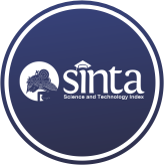Penerapan Data Mining Clustering Algoritma K-Means Untuk Menganalisa Pola Kejadian Tindak Kejahatan (Studi Kasus Polrestabes Semarang)
(1) Universitas Stikubank, Semarang, Indonesia
(2) Universitas Stikubank, Semarang, Indonesia
(*) Corresponding Author
Abstract
Full Text:
PDFReferences
S. Soekanto, Pengantar Penelitian Hukum. Jakarta: Universitas Indonesia Press, 1999.
R. I. Ndaumanu, Kusrini, and M. R. Arief, “Analisis Prediksi Tingkat Pengunduran Diri Mahasiswa dengan Metode K-Nearest Neighbor,” JATISI, vol. 1, no. 1, pp. 1–15, 2014.
L. Suriani, “Pengelompokan Data Kriminal Pada Poldasu Menentukan Pola Daerah Rawan Tindak Kriminal Menggunakan Data Mining Algoritma K-Means Clustering,” J. Sist. Komput. dan Inform., vol. 1, no. 2, p. 151, 2020, doi: 10.30865/json.v1i2.1955.
S. Stedila, R. Astuti, and F. M Basysyar, “Penerapan Data Mining Clustering Menggunakan Metode K-Means Pada Data Tindak Kriminalitas Di Polres Kabupaten Kuningan,” JATI (Jurnal Mhs. Tek. Inform., vol. 8, no. 2, pp. 1629–1636, 2024, doi: 10.36040/jati.v8i2.8790.
R. Hidayat, “Clustering Menggunakan Algoritma K-Means untuk Mengelompokan Wilayah Rawan Kejahatan di Wilayah Kabupaten Solok,” J. Ilm. Mhs. Manajemen, Bisnis dan Akunt., vol. 4, no. 5, pp. 646–654, 2022, doi: 10.32639/jimmba.v4i5.169.
F. Safnita, S. Defit, G. W. Nurcahyo, F. I. Komputer, U. Putra, and I. Yptk, “Penerapan Algoritma K-Means Dalam Pengklasteran Hasil Evaluasi Akademik Mahasiswa Abstrak,” vol. 5, no. 2, pp. 513–520, 2024.
DOI: https://doi.org/10.30645/kesatria.v5i4.480
DOI (PDF): https://doi.org/10.30645/kesatria.v5i4.480.g475
Refbacks
- There are currently no refbacks.
Published Papers Indexed/Abstracted By:














